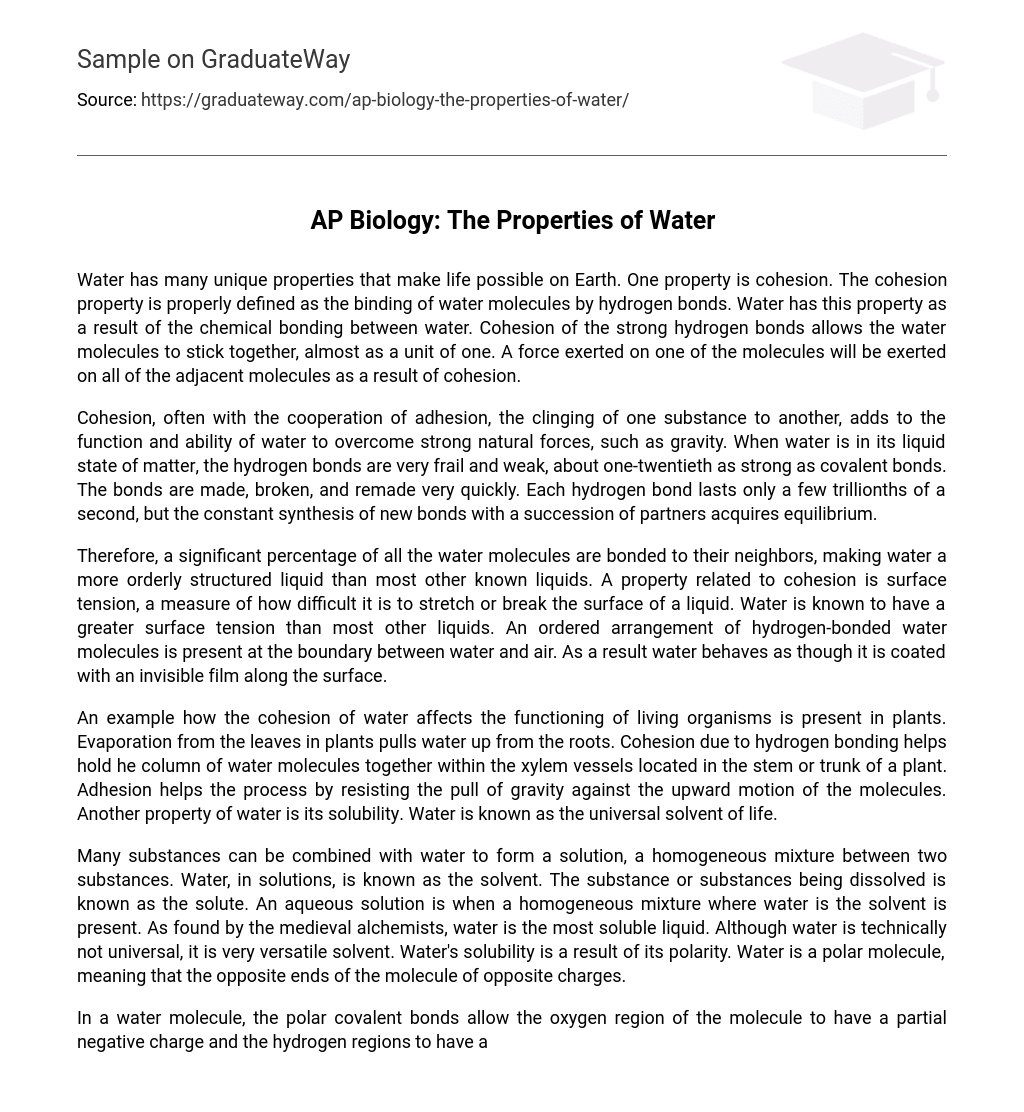Water on Earth possesses numerous distinctive characteristics that enable the existence of life. One such characteristic is cohesion, which refers to the linkage of water molecules through hydrogen bonds. This property arises from the chemical bonding within water. The robust hydrogen bonds facilitate the merging of water molecules, essentially creating a cohesive unit. Consequently, any force applied to one molecule will affect all neighboring molecules due to cohesion.
Cohesion, along with adhesion, contributes to the functionality and capability of water to overcome powerful natural forces like gravity. In its liquid state, water’s hydrogen bonds are relatively delicate and weak, approximately one-twentieth the strength of covalent bonds. These bonds are continuously formed, broken, and reformed at a rapid pace. Although each hydrogen bond lasts only a few trillionths of a second, the ongoing creation of new bonds with various partners establishes equilibrium.
Water has a higher level of organization in its liquid form compared to other liquids because many water molecules are connected to neighboring molecules. Surface tension, which is the resistance of a liquid’s surface to stretching or breaking, is a result of cohesion. Water has more surface tension than most other liquids because hydrogen-bonded water molecules are arranged orderly at the interface between water and air. As a result, water seems to have an invisible film covering its surface.
Water cohesion is important for the functioning of living organisms, like plants. When water evaporates from plant leaves, it generates a pulling force that draws water up from the roots. This cohesion relies on hydrogen bonding, which tightly holds water molecules together within the xylem vessels in the plant’s stem or trunk. Adhesion also aids by resisting gravity’s pull on upward molecular movement. Furthermore, water’s solubility is another extraordinary trait that makes it universally recognized as a solvent for supporting life.
Water is a versatile solvent that can create a solution with numerous substances, resulting in an undifferentiated mixture. In these mixtures, water acts as the solvent while the substances being dissolved are called solutes. When water is used as the solvent, it forms an aqueous solution. Medieval alchemists found that water has high solubility but not complete solubility in all cases. The polarity of water, a polar molecule with opposite charges on each end, explains its solubility.
The polar covalent bonds within a water molecule cause the oxygen area to possess a partial negative charge, while the hydrogen areas have a partial positive charge. When water is mixed with ionic crystals, these crystals remain intact instead of separating. Instead, the partially negative ion from the crystal forms a bond with the hydrogen ions in water, while the partially positive ion from the crystal forms a bond with the oxygen ions in water. This arrangement results in the creation of a hydration shell, which comprises of a sphere consisting of water molecules surrounding each dissolved ion. Gradually, all of the present ions will dissolve in water.
As a result, water, the versatile solvent, can solubilize two solutes from the salt and mix them homogeneously. Water is not only a solvent for ionic compounds but also for many polar molecules. This versatile solubility can be observed in the functioning of various liquid substances found in living organisms, including blood, plant sap, and cell fluid. The solubility of water enables these liquids to have a uniform concentration throughout, resulting in equal distribution of ions or molecules in the solution.
Water’s high specific heat, which is the amount of heat needed to change its temperature by one degree Celsius per gram, plays a crucial role in maintaining stable temperatures in natural ecosystems. It requires a significant amount of heat energy to alter water’s temperature. Specifically, water has a specific heat equivalent to one calorie per gram per degree Celsius. A calorie represents the measure of heat required to increase the temperature of one gram of water by one degree Celsius.
Water has the ability to resist temperature changes due to its high specific heat. When water undergoes a change in temperature, it either absorbs or releases a considerable amount of heat. This is because the hydrogen bonding present in water necessitates a significant amount of heat for breaking and forming bonds.
Most of the heat energy is used to break hydrogen bonds before water molecules can increase in speed, so one calorie has a negligible effect on temperature. When there is a slight decrease in temperature, many hydrogen bonds are formed, releasing a significant amount of heat energy. The high specific heat of water is closely tied to Earth’s climate and has implications for coastal areas and marine life.
Water’s remarkable properties, including its high specific heat and ability to stabilize temperature in both land and water environments, are essential for supporting life. Furthermore, animals, which consist mostly of water, can withstand changes in temperature. It is crucial to acknowledge that despite being abundant and omnipresent, water exhibits extraordinary qualities due to the structure and interactions of its molecules, demonstrating emergent properties.





